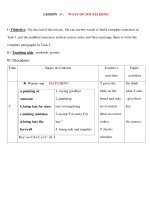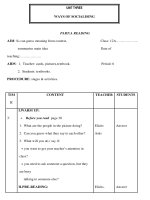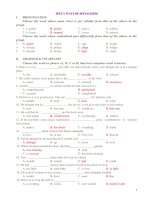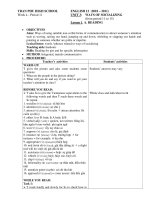Unit 3 Ways of socialising
Bạn đang xem bản rút gọn của tài liệu. Xem và tải ngay bản đầy đủ của tài liệu tại đây (1.87 MB, 40 trang )
<span class='text_page_counter'>(1)</span>
<span class='text_page_counter'>(2)</span> Match the action with the suitable picture.
<span class='text_page_counter'>(3)</span> 2. 1. 4. 3. 5. 4. a. clapping the hands. 6. 7. c. jumping up and down f. nodding his head b. pointing to the board d. whistling e. raising the hands g. waving.
<span class='text_page_counter'>(4)</span> Forms of nonverbal Some ways of communicati socializing on.
<span class='text_page_counter'>(5)</span>
<span class='text_page_counter'>(6)</span> socialize/ socialise with (v) /’səʊʃəlaɪz/ -> giao lưu, hòa nhập xã hội. socialisation (n) /səʊʃəlaɪ’zeɪʃn/ social (adj) /’səʊʃl/ : có tính xã hội non-verbal (adj) /nɒn 'vɜ:bəl/: không bằng lời >< verbal (adj) /'vɜ:bəl/: bằng lời nói.
<span class='text_page_counter'>(7)</span> UNIT 3: WAYS OF SOCIALISING A- READING I. BEFORE YOU READ. 1. What are the people in the pictures doing ? In picture 1: They are shaking hands and greeting each other. In picture 2: They are waving to say goodbye..
<span class='text_page_counter'>(8)</span> Grade 12 II. BEFORE YOU READ. UNIT 3: WAYS OF SOCIALISING A- READING. 2. What will you do and/ or say if - you want to get your teacher’s attention in class? - you need to ask someone a question, but they are busy talking to someone else? If we want to get the teacher’s attention in class, we can raise our hands slightly. If we need to ask someone a question, but they are busy talking to someone else, we can say: Excuse me, may I ask you a question?.
<span class='text_page_counter'>(9)</span> Grade 12. UNIT 3: WAYS OF SOCIALISING A- READING thu hút sự chú ý của ai bằng lời nói. Paragraph 1. To attract someone’s attention so that we might speak to that person, we can use either verbal or non-verbal forms of communication. Let us look khôngat non-verbal communication in English. Probably bằng the most common way of attracting someone’s lời nóiattention is by waving. For example, if we are at a noisy party and see a friend come in the door about 20 metres away, we might raise our hand and wave to her as a signal that we see her. tín hiệu.
<span class='text_page_counter'>(10)</span> Grade 12. UNIT 3: WAYS OF SOCIALISING A- READING. Paragraph 2 But how hard can we gave in a situation like this ? Suppose you are at the airport and you see your brother get off the plane and begin walking towards you. If you are excited, you might jump up and down and wave as hard as you can to attract his attention. This is the instance where big, obvious nonverbal signals are appropriate. rõ ràng, hiển nhiên. suitable phù hợp.
<span class='text_page_counter'>(11)</span> Grade 12. UNIT 3: WAYS OF SOCIALISING A- READING. Paragraph 3 There are, however, some social situations where smaller non-verbal signals are more appropriate. In a restaurant, for example, if we want to attract the attention of our waiter, we have several choices. We can wait until help sự trợ he passes near us, catch his eye, and nod giúp slightly to let him know we would like him to come to our table or we can raise our hand slightly to show that we need assistance. We do not whistle or clap our hands to get the person attention. That is considered impolite thô lỗ and even rude..
<span class='text_page_counter'>(12)</span> Grade 12. UNIT 3: WAYS OF SOCIALISING A- READING. sự thân mật, không trang trọng Paragraph 4. In most social situations where some informality is allowed, a brief raise of the hand and a small wave is fine. For instance, if you are walking across the schoolyard and see your teacher approaching you, a small friendly wave to attract his or her attention is appropriate. come near đến gần.
<span class='text_page_counter'>(13)</span> Grade 12. UNIT 3: WAYS OF SOCIALISING A- READING. Paragraph 5 Once you have got your friend’s attention, you shouldn’t point at the person or thing you want her to look at. A slight nod will do. Pointing at someone is usually considered rude. Of course, there are times when pointing is perfectly acceptable, such as when a teacher wants to get someone’s attention in class. The teacher often points to the students and says, “David, would you read the next sentence please?” Pointing here is not impolite; it simply a way to get someone’s attention..
<span class='text_page_counter'>(14)</span> NEW WORDS socialise with /’səʊʃəlaɪz/ (v) socialisation /səʊʃəlaɪ’zeɪʃn/ (n) social /’səʊʃl/ (adj) : attract someone’s attention: verbal. giao lưu, hòa nhập xã hội có tính xã hội thu hút sự chú ý của ai. /'vɜ:bəl/ (adj) >< non-verbal (adj) bằng lời nói >< không bằng lời formality /fɔ:'mæləti/(n) >< informality (n) Sự trang trọng >< Sự không trang trọng rude /ru:d/ (adj) thô lỗ approach /ə'prəʊt∫/ (v): tiếp cận signal /’signl/ (n) dấu hiệu rõ ràng obvious /’ɒbviəs/ (adj) sự trợ giúp assistance /ə’sistəns/ (n) phù hợp appropriate /ə’prəʊpriət/ (adj).
<span class='text_page_counter'>(15)</span> UNIT 3: WAYS OF SOCIALISING A- READING. Paragraph 5 : Paragraph 3 4: : Paragraph Paragraph 12 : : got your friend’s attention, Once you have Paragraph There are, however, some social situations where you shouldn’t point at gave thewhere person ormight thing you InTo most social situations some But how hard can we in a situation like attract someone’s attention so that we smaller non-verbal signals are more appropriate. In a want her to look at. A slight nod will do. informality isperson, allowed, aatbrief raise of the hand speak to that we can use either verbal or this ? Suppose you are the airport and you restaurant, for example, ifiswe want to attract the Pointing at someone usually considered and ayour small wave is off fine. For instance, if you non-verbal forms ofget communication. Let usbegin look see brother the plane and attention of course, our waiter, we are havetimes several choices. We rude. Of there when at non-verbal communication in English. are walking across theIfschoolyard and see walking towards you. you are excited, canpointing wait until he passes near us, catch his eye, and is perfectly acceptable, such as Probably the most common wayyou, of attracting your teacher approaching a small you might jump up and down and wave as to a teacher wants to get someone’s nodwhen slightly to let him know we would like him someone’s attention is by waving. For example, friendly wave to attract his or her attention is attention in class. The teacher often points to hard as you can to attract his attention. This comeif to table or we can hand slightly weour are at a noisy party andraise see aour friend come appropriate. the students and “David, is the instance where big, obvious nonin the door about 20says, metres away, wewould might to show that we need assistance. We do notyou whistle read the next sentence please?” Pointing verbal signals are appropriate. raise our hand and wave to her as a signal that That is or clap our hands to get the person attention. here is not impolite; it simply a way to get we see her. considered impolite and even rude. someone’s attention..
<span class='text_page_counter'>(16)</span> Grade 12 II. WHILE YOU READ. UNIT 3: WAYS OF SOCIALISING A- READING. Task 1 : Match a word in A with a phrase in B to make a meaningful expression. A 1.To attract 2.To need 3.To catch 4.To nod 5.To say. B b a. good bye d b. your attention e c. slightly c d. assistance a e. his eye.
<span class='text_page_counter'>(17)</span> Grade 12 II. WHILE YOU READ. UNIT 3: WAYS OF SOCIALISING A- READING Task 2 : Decide which of the three options below is the best title for the passage.. A. Attracting Attention : Non – verbal Cues B. Attracting Attention by Waving C. The Best Ways of Attracting Attention Key : A. Attracting Attention : Non – verbal Cues.
<span class='text_page_counter'>(18)</span> Ways of attracting somebody’s attention.
<span class='text_page_counter'>(19)</span> TASK 3: Answer the following questions. 1. What can we do when we want to attract someone’s attention? 2. What are considered to be big, obvious non-verbal signals? 3. What can we do if we want to attract the waiter’s attention? 4. If you are walking across the schoolyard and see your teacher approaching you, what can you do to attract his/her attention? 5. Why shouldn't you point at the person or thing you want your friend to look at once you’ve got his/her attention?.
<span class='text_page_counter'>(20)</span> . Answer the questions ?. 1. 2 3. 4. 5 6.
<span class='text_page_counter'>(21)</span> 1. What can we do when we want to attract someone’s attention ? → We can use either verbal or non- verbal. communication..
<span class='text_page_counter'>(22)</span> 2. What can considered to be big, obvious non – verbal signal ? → Jumping up and down and waving as. hard as you can..
<span class='text_page_counter'>(23)</span> 3. What can we do if we want to attract the waiter’s attention ? → We can wait until he passes near us, catch his eye, nod slightly to let him know we would like him to come to our table, or we may raise our hand slightly to show that we need assistance..
<span class='text_page_counter'>(24)</span> 4. If you are walking across the schoolyard and see your teacher approaching you, What can you do to attract her attention ? → You can use a small friendly wave to attract his or her attention..
<span class='text_page_counter'>(25)</span> 5. Why shouldn't you point at the person or thing ? → Because pointing at someone (it) is considered rude..
<span class='text_page_counter'>(26)</span>
<span class='text_page_counter'>(27)</span> TASK 3: Questions - Answers 1. We can use either verbal or non- verbal communication. 2. Jumping up and down and waving as hard as you can. 3. If we want to attract the waiter’s attention, we can wait until he passes near us, catch his eye, and nod slightly to let him know we would like him to come to our table. Or we can raise our hand slightly to show that we need assistance. 4. You can use a small friendly wave to attract his or her attention. 5. Because pointing at someone is usually considered rude..
<span class='text_page_counter'>(28)</span> Clapping Discusshands the meaning of whistling Whistling and hand – clapping in Vietnamese..
<span class='text_page_counter'>(29)</span> Grade 12. UNIT 3: WAYS OF SOCIALISING A- READING. III. AFTER YOU READ. Work in groups of 4 and discuss the meanings of whistling and hand-clapping in Vietnamese culture.. * Whistling: - When being happy -. * Hand-clapping: -.
<span class='text_page_counter'>(30)</span> When do people often whistle and clap hands?.
<span class='text_page_counter'>(31)</span> * Whistling: - When relaxing - When wanting to attract other people’s attention - When giving compliments (at a perfromance) - When being happy, excited about something.... * Hand-clapping: - When giving compliments - When encouraging somebody -When showing your agreement with somebody’s ideas, opinions - When wanting to attract other people’s attention - Giving signal to call some one to come, ....
<span class='text_page_counter'>(32)</span> Learn by heart the new words Prepare the new lesson.
<span class='text_page_counter'>(33)</span>
<span class='text_page_counter'>(34)</span> What action does this picture tell you?. raising the hands => raise the hands.
<span class='text_page_counter'>(35)</span> What action does this picture tell you?. Jumping up and down => jump (v).
<span class='text_page_counter'>(36)</span> What action does this picture tell you?. clapping the hands => clap the hands.
<span class='text_page_counter'>(37)</span> What action does this picture tell you?. nodding his head. => Nod (v, n).
<span class='text_page_counter'>(38)</span> What action does this picture tell you?. waving => wave (v).
<span class='text_page_counter'>(39)</span> What action does this picture tell you?. pointing to the board => point (v) to/ at.
<span class='text_page_counter'>(40)</span> What action does this picture tell you?. whistling => whistle (v).
<span class='text_page_counter'>(41)</span>









